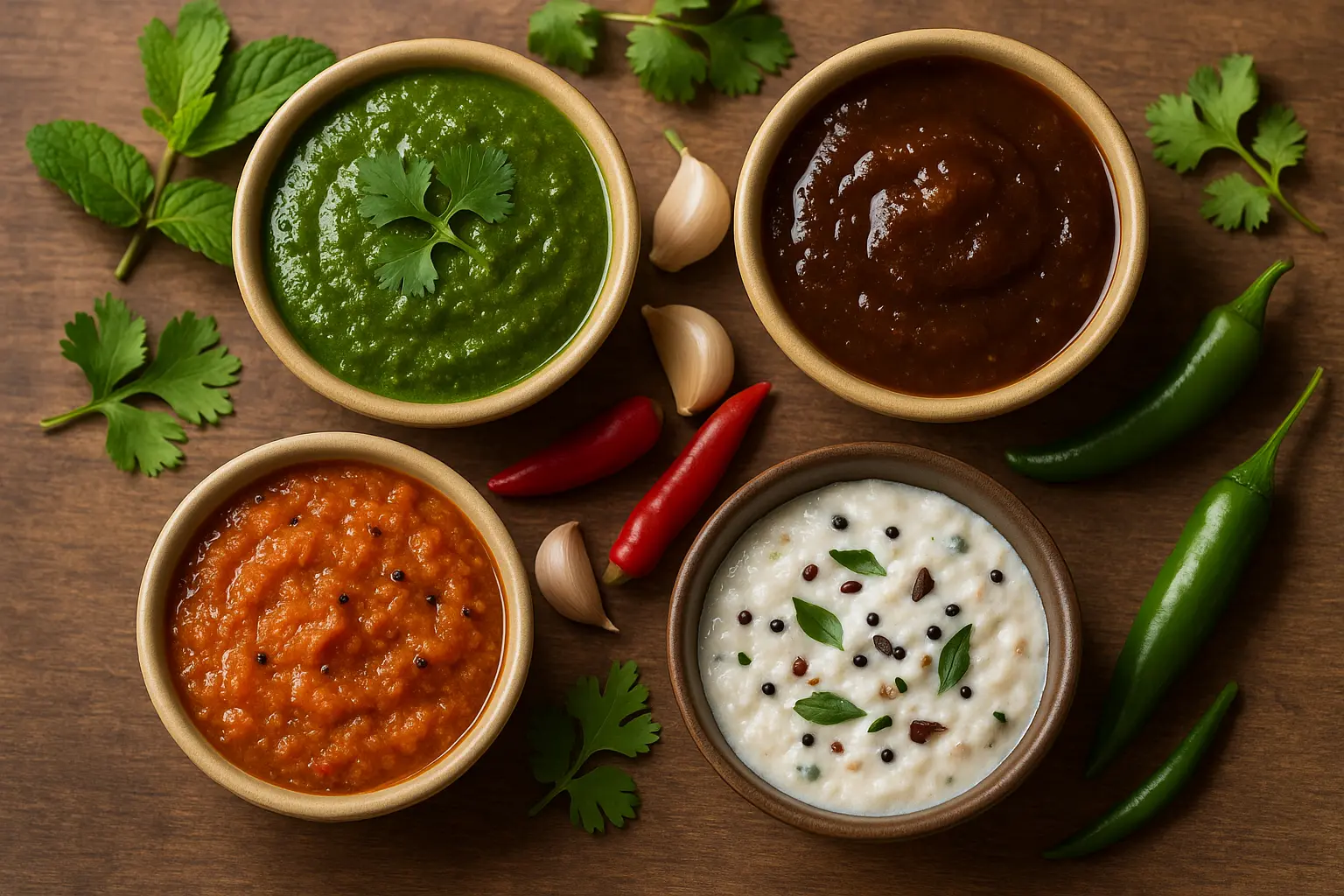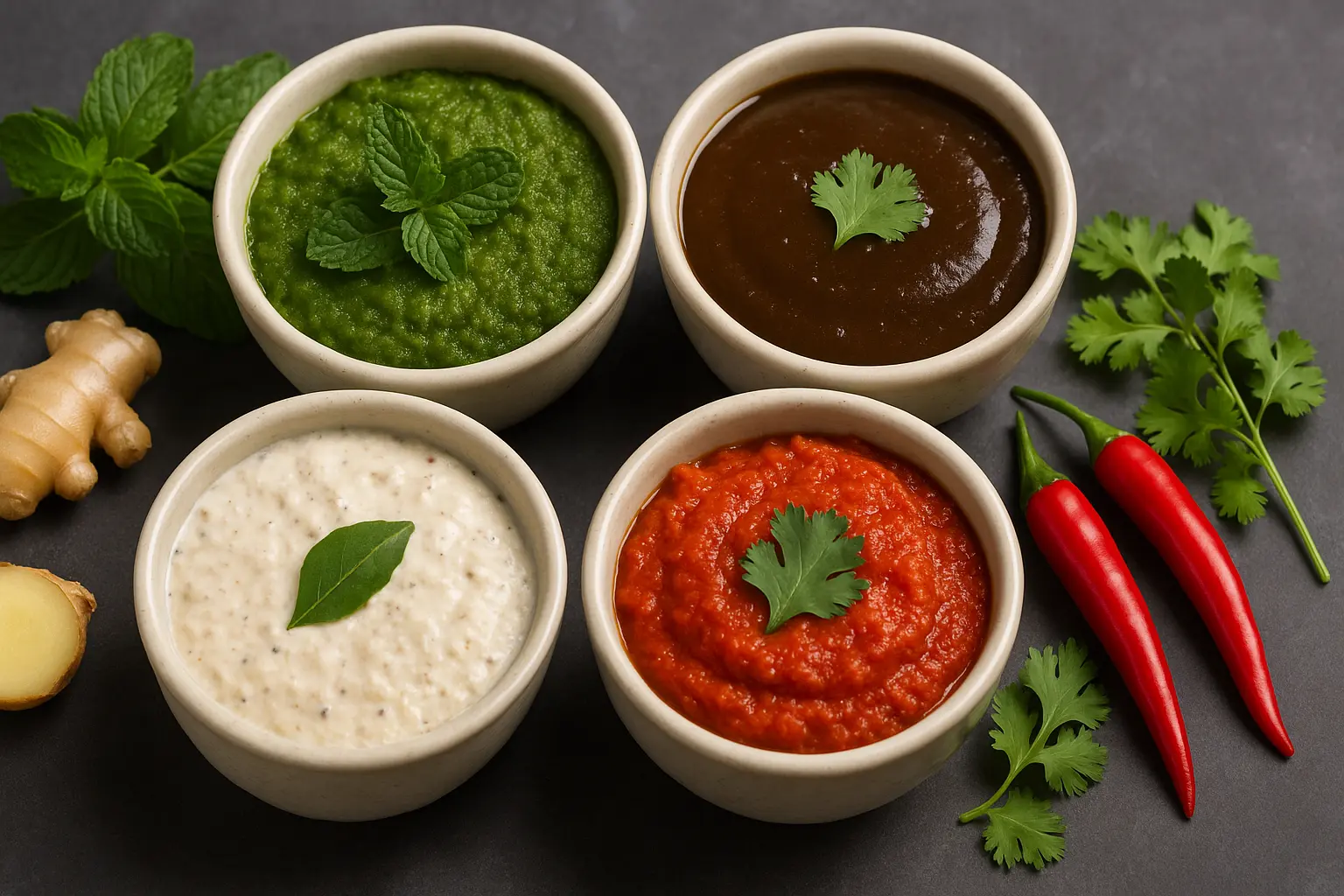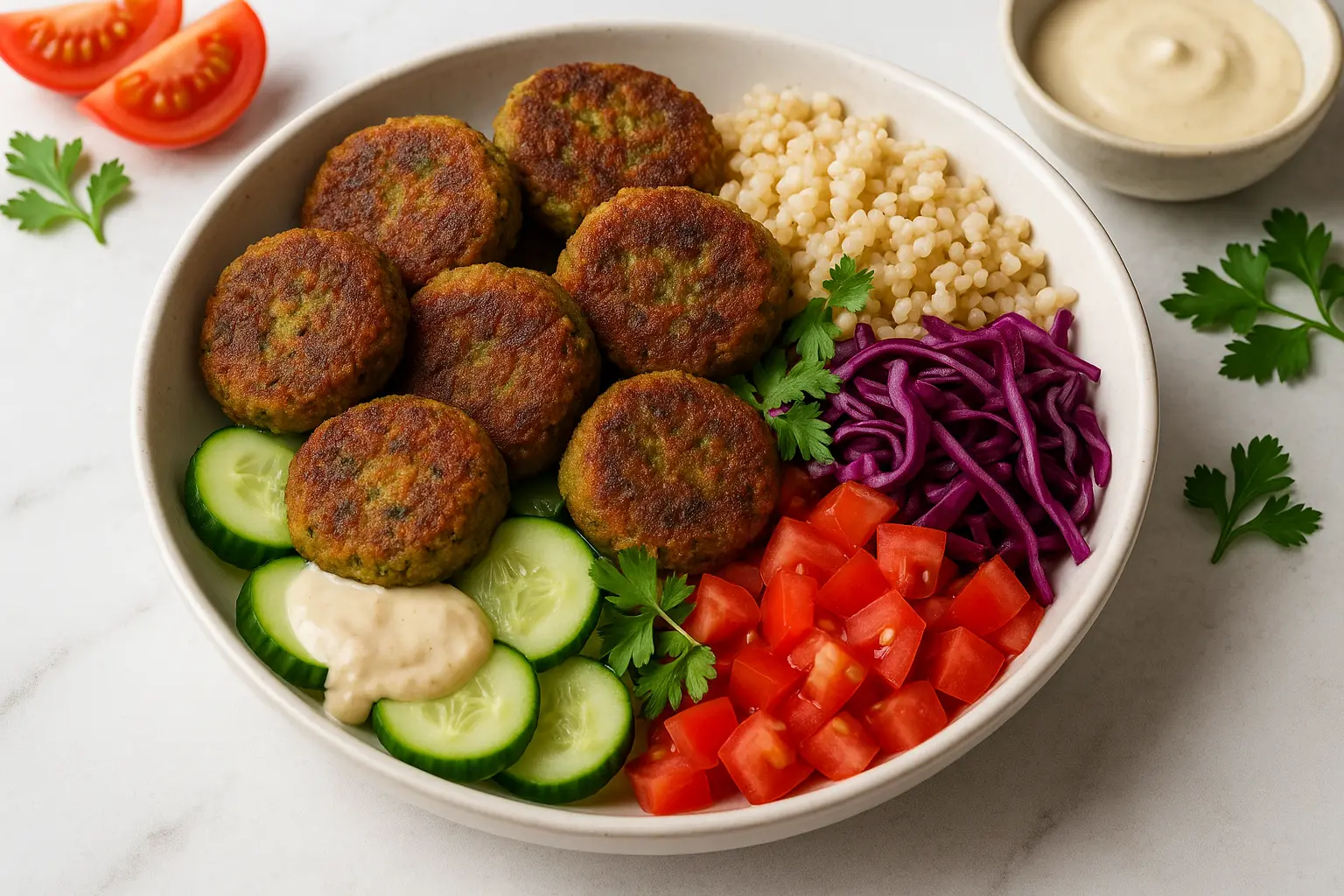In Indian cooking, chutneys are not just condiments—they are essential taste enhancers that complete a meal. Whether served alongside street food like samosas and chaats, South Indian dosas, or rich North Indian curries, chutneys add layers of flavor: tanginess, sweetness, heat, freshness, and spice.
From household kitchens to festive thalis, chutneys reflect India’s culinary diversity. Some are fresh and no-cook, prepared in minutes, while others are slow-cooked and stored for weeks. The beauty lies in their versatility—each chutney is designed to balance a dish, enhance flavors, or cut through richness.
This guide will cover classic, regional, seasonal, and innovative chutneys, along with easy recipes and pairing suggestions for every Indian dish.

1. Classic North Indian Chutneys
Mint & Coriander Chutney
Flavor profile: Fresh, tangy, spicy.
Pairs with: Samosas, pakoras, kebabs, parathas, chaats.
Basic Recipe:
1 cup fresh coriander leaves
½ cup mint leaves
1–2 green chilies
½ tsp roasted cumin powder
Juice of 1 lemon
Salt to taste
Grind all ingredients with little water until smooth. Serve immediately.
Tamarind Chutney (Imli Chutney)
Flavor profile: Sweet-sour, slightly spicy.
Pairs with: Chaats (pani puri, dahi puri, sev puri), samosas, kachoris.
Basic Recipe:
1 cup tamarind pulp
¾ cup jaggery (or brown sugar)
½ tsp dry ginger powder
1 tsp roasted cumin powder
1 tsp black salt
Simmer until thick and glossy. Cool before serving.
Garlic Chutney (Lahsun Chutney)
Flavor profile: Spicy, pungent, earthy.
Pairs with: Vada pav, roti, parathas, stuffed bread rolls.
Quick Recipe:
10–12 garlic cloves
2–3 dry red chilies (soaked)
1 tsp lemon juice
Salt to taste
Blend into a coarse paste. Can be stored in the fridge.
2. South Indian Favorites
Coconut Chutney
Flavor profile: Creamy, mildly spiced, fresh.
Pairs with: Dosas, idlis, uttapams, upma.
Classic Version:
1 cup grated fresh coconut
2 tbsp roasted chana dal
1 green chili
½ inch ginger
Salt to taste
Grind into a smooth paste with little water.
Tempering (optional): Heat 1 tsp oil, add mustard seeds, curry leaves, dry red chili, and pour over chutney.
Tomato Chutney
Flavor profile: Tangy, spicy, slightly sweet.
Pairs with: Dosas, idlis, plain rice, chapati.
Quick Recipe:
2 ripe tomatoes (chopped)
1 onion
2 garlic cloves
2 dry red chilies
Salt to taste
Sauté onion, garlic, and chilies, then add tomatoes. Cook till soft, cool, and blend.
Curry Leaf Chutney
Flavor profile: Earthy, aromatic.
Pairs with: Rice, dosas, millet dishes.
Recipe:
1 cup curry leaves
2 tbsp grated coconut
1 tbsp roasted chana dal
Tamarind pulp (small piece)
Salt to taste
Grind and temper with mustard seeds and curry leaves.
3. Regional Specialties Across India
Maharashtrian Peanut Chutney
Flavor profile: Nutty, spicy, tangy.
Pairs with: Bhakri (millet flatbread), poha, upma.
Gujarati Green Chutney
Made with coriander, green chilies, ginger, lemon juice.
Essential with fafda, dhokla, thepla.
Kashmiri Walnut Chutney (Doenjang)
Rich, creamy chutney with walnuts, yogurt, green chilies, and mint.
Pairs with kebabs, grilled meats, rice dishes.
Bengali Kasundi (Mustard Chutney)
Tangy, pungent, mustard-based chutney.
Served with fried fish, cutlets, rice.
4. Sweet & Fruit-Based Chutneys
Mango Chutney
Flavor profile: Sweet-spicy.
Pairs with: Rice, curries, rotis, fried snacks.
Pineapple Chutney
Popular in Bengali cuisine.
Sweet, tangy, served with pulao, curries.
Apple & Date Chutney
Balanced sweetness, fiber-rich.
Great for festive meals and as a dip.
5. No-Cook & Quick Chutneys
Onion Chutney: Sliced onion, green chili, lemon juice, salt.
Cucumber Yogurt Chutney (Kheera Raita style): Yogurt with grated cucumber, roasted cumin, and mint.
Mint-Curd Chutney: Blends mint leaves, yogurt, and spices—ideal for tikkas.
These take under 10 minutes and are excellent for busy weeknights.
6. Pairing Chutneys With Indian Dishes
Snacks & Street Food: Mint-coriander + tamarind chutney.
Parathas: Garlic chutney, mint-curd chutney.
Rice & Pulao: Tomato, coconut, or peanut chutney.
South Indian Tiffins: Coconut, curry leaf, onion chutneys.
Festive Thalis: Sweet mango, pineapple, apple chutneys.
7. Chutney Storage Tips
Refrigerate fresh chutneys in airtight jars (2–3 days).
Add lemon juice or vinegar to extend shelf life.
Cooked chutneys like tamarind or mango last 2–3 weeks.
Freeze in ice cube trays for small servings.
8. Health & Lifestyle Angle
Vegan & Gluten-Free: Most chutneys are naturally vegan.
Low-Calorie: Fresh chutneys add flavor without heaviness.
Digestive Benefits: Tamarind, ginger, garlic, and cumin aid digestion.
Nutrient Boost: Mint, coriander, curry leaves provide vitamins & antioxidants.
9. Innovative Twists on Traditional Chutneys
Avocado Mint Chutney: Creamy, nutrient-rich, great with kebabs.
Beetroot Chutney: Vibrant color, earthy-sweet taste.
Pumpkin Chutney: Seasonal, mildly sweet, pairs with rotis.
Green Apple & Basil Chutney: Fusion take on coriander chutney.
10. Chutneys for Special Occasions
Festivals (Diwali, Holi): Sweet mango or date chutney.
Picnics: Dry garlic chutney powder, peanut chutney (travel-friendly).
Parties: Trio platter—mint-coriander, tamarind, mango chutney.
Street Food Nights: Onion, tomato, and garlic chutneys.
Conclusion: Elevating Everyday Meals
Chutneys embody the heart of Indian food—bridging tradition, seasonality, and creativity. From no-cook mint blends to festive fruit chutneys, each variation enhances the dish it accompanies. They are not just sides but essentials that transform ordinary meals into memorable culinary experiences.
Next time you make parathas, pakoras, or dosas, remember: the chutney you serve is just as important as the dish itself.
Leave a comment
Your email address will not be published. Required fields are marked *




















